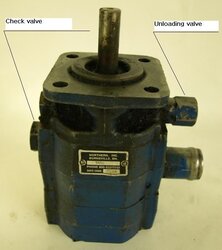I'm running dad's 25 yr old Northern splitter, and whenever I have it is when things go wrong. I don't want him splitting anymore, so I'd rather bring him the wood, and let him just worry about stacking & burning but I digress.
Recent symptom is that the piston extends to the log, but has no power to push through. With no log on the beam it will go back & forth, just has no power.
I changed out the oil which hadn't been done in a few years, and cleaned the pick up screen, which was mucky.- no change.
Before I order a new hydraulic pump, is there something else I should be checking?
Thanks
Chris
Recent symptom is that the piston extends to the log, but has no power to push through. With no log on the beam it will go back & forth, just has no power.
I changed out the oil which hadn't been done in a few years, and cleaned the pick up screen, which was mucky.- no change.
Before I order a new hydraulic pump, is there something else I should be checking?
Thanks
Chris


